The Majesty of The Blues
“Rhythmically, melodically and emotionally, he’s hitting nothing but bull’s eyes,” the Village Voice said of this album devoted entirely to Wynton’s own compositions. Two tunes for sextet, including the truly majestic title track, lead into “The New Orleans Function,” a three part piece that pivots around a sermon on jazz, “Premature Autopsies,” written by Stanley Crouch and delivered by Reverend Jeremiah Wright, Jr., and that features the playing of New Orleans music masters Dr. Michael White on clarinet, Danny Barker on banjo, Teddy Riley on trumpet, and Freddie Lonzo on trombone.
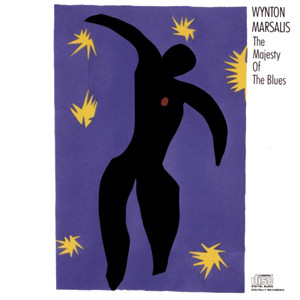
Album Info
| Ensemble | Multiple Ensembles |
|---|---|
| Release Date | June 13th, 1989 |
| Recording Date | October 27 and 28, 1988 |
| Record Label | Columbia Records |
| Catalogue Number | CK 45091 |
| Formats | CD, LP |
| Genre | Jazz Recordings |
Track Listing
| Track | Length | Preview |
|---|---|---|
| The Majesty Of The Blues (The Puheeman Strut) | 15:07 | Play |
| Hickory Dickory Dock | 9:07 | Play |
| The Death Of Jazz | 12:39 | Play |
| Premature Autopsies (Sermon) | 16:23 | Play |
| Oh, But On The Third Day (Happy Feet Blues) | 6:45 | Play |
Liner Notes
This album is a fresh start for Wynton Marsalis, but it is also a development of all that he has done on his previous records. From the opening notes of the title track through the three-part, half-hour works that fills the second side, we hear Marsalis coming in even closer contact with the wisdom of a music built on the rhythms and the colors of the blues. Not only are we given the mysterious and jaunty weight of sound he draws from his new sextet, but Marsalis also goes back to the New Orleans ensemble roots of jazz. The result is an album that has a wider stylistic span than any other studio work done under the name of Wynton Marsalis, a span that further investigates the gutbucket majesty of the blues and explores the ceremonial depths of a tradition that has brought about the most original aesthetic mutations in the music of America.
Though Marsalis has been at the front of an unacknowledged vanguard for the last few years, working out in his last band approaches to rhythmic complexity and group improvisation that had no precedent in control, passion, and intellectual depth, he is in the process of stripping away the things he now finds at odds with his present state of development. Hemingway described the process Marsalis is going through in A Moveable Feast thusly, “Since I had started to break down all my writing and get rid of all facility and try to make instead of describe, writing had been wonderful to do.” In other words, his writing became the event of experience itself, not a description of it. As a man with a genius for the playing of the trumpet, Marsalis has had to work his way through the given aspects of his gift to a position of expression that he now perceives with a maturing accuracy.
“I knew,” he says, “that when I did that album at Blues Alley that I wasn’t going to do another record in that type of style–all those really complex rhythms, playing fast, wild. Now I’m trying to really put together an approach through which I can create a more accurate tonal picture of my experiences, of the world I come out of, of the things in my life that have the deepest meanings for me. A lot of it has to do with all the things I experienced growing up in New Orleans, that kind of feeling of fraternity, of humor, of style, food, dances, parades, churches, ribbing, family, sports, girls–all of it. I can do this better right now because I think I’m at a place where I really understand what jazz is. This direction I’m going in now allows me to address more of the fundamentals of the music and to dig deeper into my own experiences. This vision is more my own because I’m leaving the realm of just pure music and entering into the realm of experience and music.”
Perhaps the most important statement made here is a removal of the supposed generation gaps that have bedeviled jazz since musicians began to emerge who were able to play with authority in only one style. By bringing together the musicians he uses on this recording, Marsalis is reiterating a sense of musical wholeness that suggests the arrival of a musical renaissance in jazz, one in which the varied powers of the art are reborn through a sensibility broad enough to not only appreciate but reinvent the tradition itself. This would not be possible if Marsalis hadn’t spent so much time studying the work of the masters of his art and seeking the connectives that transcend particular styles. That level of involvement has allowed him to move beyond what could easily be a superficial breadth of sound that lacks the spiritual, emotional, intellectual, and technical bite of authority. Marsalis is intelligent enough to understand that when one truly grasps the conception that undergirds a musical approach it isn’t necessary to imitate the execution.
“I’m realizing,” he says, “that a musician should not ape or imitate these styles. When you’re imitating, you are on the lowest level of cognizance, which is technical. The technical level is the lowest level, but that’s also the level that lets you know who’s going to make it. It’s like a guard at the door, and that’s what technique is like; and to those who can’t pass that test, the guard says, ‘No, not you.’ I want to use the technology of music to better illuminate the meaning of the music. The technical devices in art always come about for human reasons, then through repetition they become techniques. But when you lose sight of the origins and lose contact with what your actual experience means, you have difficulty translating them into music. But if you have experiences that are important, once you figure out how to translate them, you have worlds of musical possibility laying dormant inside yourself. That’s the peril of overrefining and underrefining: if you overrefine, you get lost in the music; if you underrefine, you get lost in the experience. Either one results in going away from who you really are.”
What Marsalis is now after has been in the works from the point at which he began to understand the importance of Louis Armstrong, that aesthetic shepherd with a huge clarion tone and a sense of melodic elevation propelled by the rhythm of swing. Armstrong was a door to the recognition of the powers that lay inside the New Orleans tradition, that lay inside the very identity of America itself, a democratic synthesis of moods and meanings that even those born in barrels of butcher knives could use to create noble structures in rhythm and tune. His studies of Thelonious Monk brought Marsalis in touch with yet another vision of musical clarity, wit, lyricism, and an uncompromising nobility that demanded compositions and improvisations of almost intimidating comprehensiveness. The work of Charlie Parker and John Coltrane gave him a stronger sense of the best uses of velocity technique, harmonic sophistication, and personal as well as ensemble rhythm. Ornette Coleman’s early quartet music provided the trumpeter with insights into phrasing and harmonic liberties rooted in the blues shout, cry, and shuffle. But, of late, his examination of the music made by Duke Ellington and Jelly Roll Morton has given him the frame of largest musical reference, allowing Marsalis to see how all that he has learned thus far can be brought together for the various forms of ensemble work and improvising built upon the blues.
“In order to understand the meaning of an art form, you have to find out what the greatest artists have in common. From my studies I have found out something different from what I thought when I was growing up. In the ignorance of overrefinement, we thought that the blues was the simplest form to play. We didn’t even think you had to play blues. We only recognized things like Giant Steps because it had a lot of chord changes on it. The only difficulty we recognized was harmonic. But that’s a fallacy because you find out through study that blues is the single element that connects the greatest jazz musicians. Why is that? Because blues has the emotional, harmonic, and technical depth to inform whatever you do in this music.
“The blues addresses the central chords of Western harmony, the I, the IV, and the V chords. Its central progression is the I, IV, I, or ‘amen’ cadence in Western religious music. It’s also a style and a form that gives you access to all 12 notes at any given time because the notes that are not in the key are non-harmonic tones, and those non-harmonic tones are blues notes. If you are in the key of C major, C, D, E, F, G, a, and B are the seven primary notes. B flat, the flat seventh, is a blues note; A flat, the flat sixth, is a blues note; G flat, the flat five, is a blues note; E flat, the flat third, is a blues note; D flat, the note Dizzy Gillespie uses on his blues Wheatleigh Hall, is the minor second. So, there’s all 12 notes of the chromatic scale right there.
“Though you have all 12 notes right there, the essence of the blues is a sound. There are notes within that sound which are not heard in the tempered scale, Negroidal timbral essences which are heard in the blues signers and in the band of Duke Ellington. Ellington would arrange music so that these tones would come out, tones that are not in the Western scale. By a sophisticated and successful combination of notes, the chords and the harmony would bend. In this way, the blues is a whole form and an innovation in the history of Western and African music simultaneously. When you add to that the percussive elements that have to be refined and dealt with that also come out of the American experience, the Negroization of the melodic properties of American music through the unique use of the major sixth interval, there is much to be done, all of which demands a specific kind of technical skill.
“That’s why all of the great jazz musicians have been strong technicians on some level. But techniques vary. Take a titan like Thelonious Monk; he invented an entire technique for the piano because the European approach was not sufficient for what he wanted to do. Monk was focused on the sound that has its basis in the blues, and everything he did took direction from that. Coltrane, who had the kind of velocity technique people recognize, was always coming from the blues sound, as was Bird. Ornette Coleman’s whole conception is based in the harmonic freedom implied by the meaning of the blues note in and out of the scale.”
As one can easily hear on the two sextet tracks, Marsalis has once again proven himself the best young talent scout in the genre. This group perfectly fits his present ambitions: each player has a very strong sense of what constitutes the sound of jazz, of blues, of swing. Only pianist Marcus Roberts remains from the previous band, and his position as the most soulful of the younger pianists stands unchallenged. His sound is taking on more weight, and the gift he has for organizing superb thematic improvisations with harmonic and rhythmic darts that pierce the bull’s-eyes of the chords and the time continues to evolve with down-home intensity and grace.
Born in 1964 and 1967 respectively, Brooklyn alto saxophonist Wes Anderson and St. Louis tenor saxophonist Todd Williams, who also doubles on soprano, are two more indications of the renaissance presently taking place. Though he initially started on piano, Anderson switched to alto saxophone when he heard Charlie Parker. On the advice of Branford Marsalis, he went to Southern University in Baton Rouge to study with Alvin Batiste. Anderson credits Batiste with giving him a thorough technical background and introducing him to the polyphonic style of New Orleans music. Williams began playing the saxophone at ten and met Wynton Marsalis in 1984; the trumpeter encouraged him to listen to Sonny Rollins. A few years later, he memorialized and played Coltrane’s entire improvisation from Crescent for his future bandleader, which the trumpeter understandably found quite impressive. Marsalis sent Williams a big pile of tapes of Coltrane, Lester Young, Sonny Rollins, Ben Webster, Charlie Parker, and many others in the summer of 1986. A year later, Williams joined the band. Both of the saxophonists play with startling authenticity for their ages. For the whop of a deep blues shock, listen to them both on the first section of the three part work on side two. Soon all will know.
Bassist Reginald Veal and drummer Herlin Riley are both from New Orleans. Born in 1963, Veal already has a huge tone, knows how to groove, invents fine bass lines, and swings with a throttle on their time that should make his mentor, Ellis Marsalis, quite proud. Riley, who was born in 1957, has played trumpet and is part of a renowned New Orleans musical family, the Lasties. He possesses an exquisite conception of time and timbre, which allows him to bring an intricate and precise variety of colors to the phrasing of the beat. His wonderful work with Ahmad Jamal was perfect preparation for the role he plays so well in this band.
Gathered with Marsalis and the members of the sextet are New Orleans musicians he brought to New York for this session in order to get as close to the spiritual grit and knowledge of the tradition as possible. This is unusual in that none of Marsalis’ contemporaries, even when they have performed or recorded with older players, have reached across what is superficially such a large, stylistic gap. But Marsalis doesn’t see it as a gap at all; what he feels is that this gathering allows him to reach into a musical source that he was fortunate enough to experience when he was first learning how to play.
The selection of 80-year-old Danny Barker was especially important to him. “I first played with Danny Barker when I was eight years old, but I was too dumb to know what it was. My attitude was that I didn’t want to march around playing my trumpet. We used to rehearse in the eighth ward across from St. Mark’s Community Center. Danny Barker was one of the guys who taught young musicians how to play. He knew the New Orleans tradition. He could tell you how things were supposed to go, the stories of the musicians and the lore and the myth of the origins. He’s the kind of musician that you try to impress because Danny Barker embodies what the younger musicians who are serious need to know. He represents the continuum of the music because he can appreciate styles that he doesn’t play provided they address the fundamentals of the art. Danny Barker knew and heard all of the great New Orleans musicians when they were young men–Louis Armstrong, King Oliver, Jelly Roll Morton. He also worked with Benny Carter, Cab Calloway, and heard Duke Ellington, Count Basie and all those musicians when they were coming into their own. Having played in parades, parties, clubs, big bands, and all kinds of studio sessions, he has a richer vision of the heritage, style and majesty of the music than most people. When he agreed to bring his banjo to record with me, I felt honored.
“It also gave me an opportunity to let him hear what I had learned. In my early years I thought that New Orleans music was just about some Uncle Tomming. I was around it all the time, but wasn’t involved on the level I now know I should have been. Actually, when I was in high school, I played some parades and I really dug them then. But even so, I was still washed in that stigma of 1970′s ignorance and wouldn’t let myself dig it as much as I really did. Deep down, though, I loved the feeling of it, of all the people responding to the music and dancing to it. They would improvise, too, the people would. If we stoked up a groove in a different rhythm from the one we were playing, changing the beat, the people would get right into that beat so that you had a call and response between the dancers and the musicians, inspiring each other. I can’t even fully express the gratitude I have for what Danny Barker gave me, Branford, Shannon Powell, Leroy Jones, Herlin Riley, and all of us who played with him in the Fairview Baptist Church Band.”
Trumpeter Teddy Riley, who plays the second trumpet improvisation on “The Death of Jazz” and the feature on “Oh, But On the Third Day!” is 64 years old and now wears the crown of local New Orleans trumpet players. “I used to hear him when my daddy was playing with him,” says Marsalis, “and he has the perfect understanding of the style that I wanted on this record. So do Freddie Lonzo and Dr. Michael White, who play trombone and clarinet. They all give that real feeling and authentic depth to the music.”
On the title track, Marsalis is working with interludes, different key signatures, a variation on a shuffle groove, and motifs. The second track is “a children’s tune, a combination of a march and a church shuffle. It’s in 3/4 and 4/4. We play a toy soldier part on the march section and then a church-derived piece of music in the gospel groove. Like on “The Majesty of the Blues,” we also have call-and-response parts, little interludes, key changes, and things that exploit the colors of the band.”
The long work that fills side two is Marsalis reaching down into the ceremonial aspect of the tradition, moving from a funeral march to a sermon to jubilation as the band comes back from the burying ground with an affirmative prance bent on beating the Devil and death itself. The sermon was written by this writer and is based on the ideas Marsalis expressed in an improvised monologue he gave when introducing the first section of this work. It is delivered by Chicago’s Reverend Dr. Jeremiah Wright whose style I studied on tapes provided by Michael Hill. For those who might think that Marsalis is going backwards, he has some concluding observations about what direction his music is now taking.
“I’m not going backward in any way. What I’m doing is part of this time, too. I’m just seeking a much more comprehensive mode of expression. What I’d like to say to all the musicians is you have to deal with the blues. You have got to learn how to play the blues, not this misconception of folk blues that so many people run around with, misled and lacking the proper level of respect for that music. The blues is a very deep form in the myth of America. It’s like any mythic story: it can be taken as something nice and entertaining on the lowest level, or it can be taken as something that addresses the depths of that people’s consciousness. Like Al Murray says in Stomping the Blues, which all musicians of my generation should read, there is this sense of affirmation in the face of adversity. Blues is like a tonic, or a home base: it’s always there waiting for you, providing you with the strength and the sense of direction that you need to address the complexities of life. That’s why it was so basic to Duke Ellington’s conception. He understood the comprehensiveness of the blues and knew how to manipulate it for statements that could range from the most provincial to the most universally profound. What I am doing now is looking at it like the prodigal son. You can travel as far away from it as you want to, but it’s there waiting for you with open arms, love, and complete support for everything you do. What you must do is endure the pain of coming to grips with your origins and your identity. Then your direction is absolutely clear.”
–Stanley Crouch
Credits
THE MAJESTY OF THE BLUES
(THE PUHEEMAN STRUT)
HICKORY DICKORY DOCK
Musicians:
The Wynton Marsalis Sextet
Wynton Marsalis: Trumpet
Marcus Roberts: Piano
Todd Williams: Tenor & Soprano Saxophone
Reginald Veal: Bass
Wessel Anderson: Altoo Saxophone
Herlin Riley: Drums
THE NEW ORLEANS FUNCTION
THE DEATH OF JAZZ PREMATURE AUTOPSIES (SERMON)
OH, BUT ON THE THIRD DAY (HAPPY FEET BLUES)
Musicians:
The Wynton Marsalis Sextet
along with Dr. Michael White: Clarinet
Danny Barker: Banjo
Teddy Riley: 1st Trumpet
Wynton: 2nd Trumpet & Plunger Mute
Freddie Lonzo: Trombone
Produced by Steve Epstein.
Executive Producer: George Butler
Engineer: Tim Geelan
Assistant Engineer: Dennis Ferrante
Recorded at RCA Studio A, October 27 & 28, 1988
All songs written by Wynton Marsalis.
Sermon written by Stanley Crouch and narrated by Reverend Jeremiah Wright, Jr.
Exclusive Personal and Financial Management:
AMG International P.O. Box 55398, Washington, DC 20011
Edward C. Arrendell II, Vernon H. Hammond III, Partners
Booking Agency:
Agency For The Performing Arts
888 Seventh Avenue, New York, NY 10106, (212) 582-1500
Agency for The Performing Arts
9000 Sunset Boulevard Los Angeles, CA 90069, (213) 273-0744
Piano provided by Steinway.
Cover art: Henri Matisse. “Icarus,” From Jazz.
Copyright succession H. Matisse/Ars N.Y, 1989
Art Direction: Josephine DiDonato
Back Cover Photography: Frank Stewart
Personnel
- Freddie Lonzo – trombone
- Reginald Veal – bass
- Todd Williams – tenor sax, soprano sax
- Wycliffe Gordon – trombone
- Marcus Roberts – piano
- Dr. Michael White – clarinet
- Danny Barker – banjo
- Wess “Warmdaddy” Anderson – alto sax, sopranino sax
- Teddy Riley – trumpet
Also of Interest
-
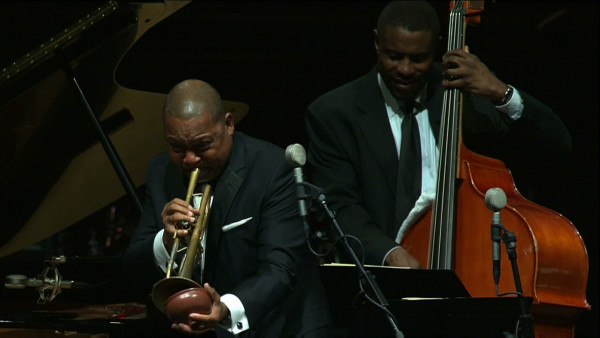 Videos
Videos
Marian Anderson Award (performance and speech) - Wynton Marsalis Septet
-
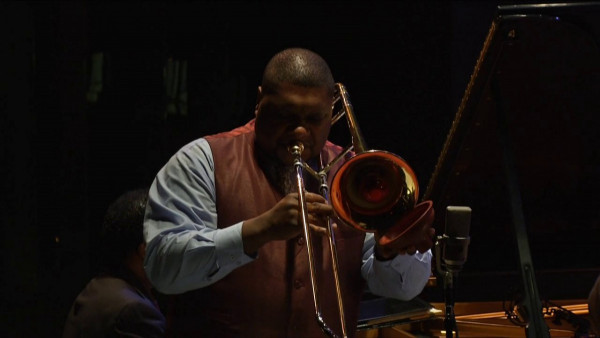 Videos
Videos
The Death of Jazz (The New Orleans Function) - Wynton Marsalis Septet at Dizzy’s Club 2013
-
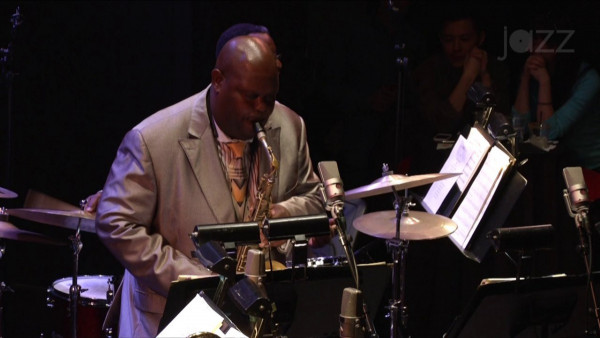 Videos
Videos
Oh, But On The Third Day (The New Orleans Function) - Wynton Marsalis Septet at Dizzy’s Club 2013
-
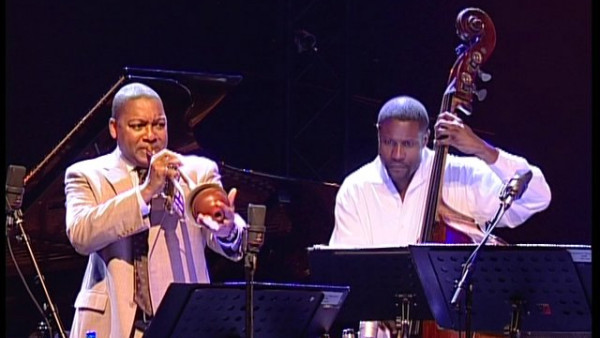 Videos
Videos
The Majesty of The Blues - Wynton Marsalis Septet at Jazz in Marciac 2008
-
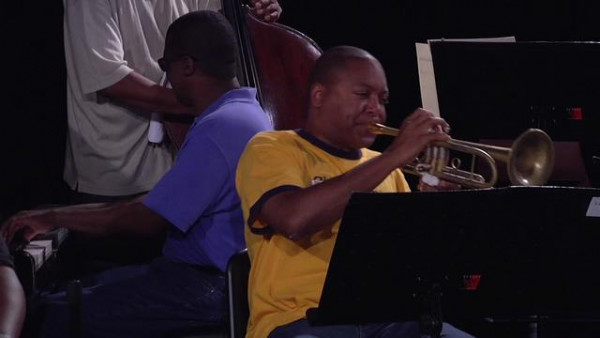 Videos
Videos
The Majesty of The Blues (rehearsal) - Wynton Marsalis Septet at Jazz in Marciac 2008
-
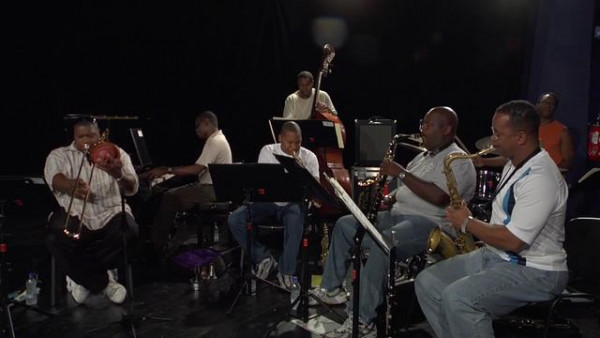 Videos
Videos
The Majesty of The Blues (take 2, rehearsal) - Wynton Marsalis Septet at Jazz in Marciac 2008
-
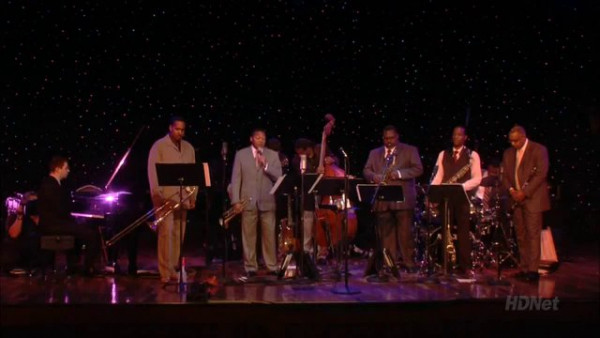 Videos
Videos
Oh, But On The Third Day (Happy Feet Blues) - Wynton Marsalis Septet in New Orleans (2006)
-
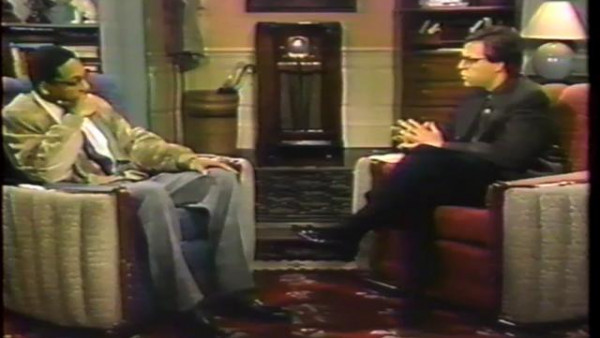 Videos
Videos
Wynton Marsalis on “Later with Bob Costas” (1990)
